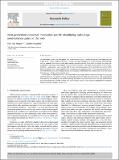Notice
This is not the latest version of this item. The latest version can be found at:https://dspace.mit.edu/handle/1721.1/134143.2
Next-generation consumer innovation search: Identifying early-stage need-solution pairs on the web
| dc.contributor.author | von Hippel, Eric | |
| dc.contributor.author | Kaulartz, Sandro | |
| dc.date.accessioned | 2021-10-27T19:58:19Z | |
| dc.date.available | 2021-10-27T19:58:19Z | |
| dc.date.issued | 2021 | |
| dc.identifier.uri | https://hdl.handle.net/1721.1/134143 | |
| dc.description.abstract | © 2020 The Author(s) All innovations consist of a need paired with a responsive solution - a need-solution pair (von Hippel and von Krogh 2016). Today, technical advances in machine learning techniques for natural language understanding, such as semantic word space models and semantic network analytics, have made it practical to capture descriptions of early-stage, need-solution pairs mentioned anywhere in the open, textual content of the Internet. Producers - and anyone - can now thus look for user innovations posted on the web that may involve either known or newly defined needs coupled to new solutions that are gaining traction. This is important because, as is now understood, users, rather than producers, tend to pioneer functionally new products and services for which both the need and the solution may be novel. In this paper, we demonstrate via a case study both the practicality and the value of searching for early-stage need-solution pairs via machine learning methods and assessing the likely general interest in each usergenerated innovation by also identifying the trends in posting and query frequencies related to it. The new need-solution pair search method we describe and test here can, we claim, serve as a very valuable complement to traditional market research techniques and practices. | |
| dc.language.iso | en | |
| dc.publisher | Elsevier BV | |
| dc.relation.isversionof | 10.1016/J.RESPOL.2020.104056 | |
| dc.rights | Creative Commons Attribution 4.0 International license | |
| dc.rights.uri | https://creativecommons.org/licenses/by/4.0/ | |
| dc.source | Elsevier | |
| dc.title | Next-generation consumer innovation search: Identifying early-stage need-solution pairs on the web | |
| dc.type | Article | |
| dc.relation.journal | Research Policy | |
| dc.eprint.version | Final published version | |
| dc.type.uri | http://purl.org/eprint/type/JournalArticle | |
| eprint.status | http://purl.org/eprint/status/PeerReviewed | |
| dc.date.updated | 2021-03-22T15:31:01Z | |
| dspace.orderedauthors | von Hippel, E; Kaulartz, S | |
| dspace.date.submission | 2021-03-22T15:31:03Z | |
| mit.journal.volume | 50 | |
| mit.journal.issue | 8 | |
| mit.license | PUBLISHER_CC | |
| mit.metadata.status | Authority Work and Publication Information Needed |
